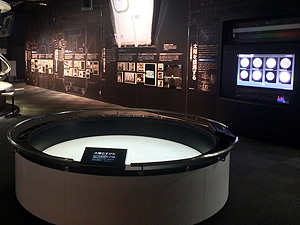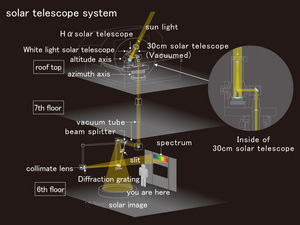Nagoya City Science Museum
TOP > Exhibition Guide > Keyword Search > Starting with "T" > telescope > Observing the Sun
Observing the Sun



Purpose of Exhibition
A huge image of the sun 194cm in diameter, presented in an exhibition room where the light from a 30cm-caliber solar telescope is shone with a vacuumed pipe, can be enjoyed on the rooftop of the Science and Technology Building. It is the largest existing figure in the world as of 2010. What's more, the solar spectrum is also projected by dispersing part of the light by diffraction grating. There is a large touch panel monitor that shows the surface of the sun from the past. The sun, which is the closest star to the earth, can be observed in these ways.
Additional Knowledge
<Telescope Exclusively for the Observation of the Sun>
Since sunlight is extremely strong, you should not look at the sun with a telescope and binoculars. It is a powerful light that ignites only by collecting light with a magnifier. There is a risk of blindness. Therefore, you do not look into the solar telescope in this exhibition to observe the sun, but instead a solar image is projected on a screen in large scale. Here, you can safely see impressive sunspots and the figure of the sun. It was in 1987 that a similar model of the solar telescope with a 25 cm caliber was first exhibited in the solar laboratory on the 2nd floor of the old Astronomy Building. A 30cm-caliber solar telescope has been assembled with cutting edge technology together with the renovation of this museum so that the telescope can suit the form of the new building.
[Clear figure of the Sun through the Vacuumed Pipe]
The light collected by the telescope goes through a long pipe until it is projected on a screen. When the sunlight shoots through the pipe, the temperature in the pipe rises. Consequently, air convection is caused and the image of the sun is blurred. It is like how you see a view in air turbulence. In this exhibit, air is removed from the pipe and the pipe is vacuumed. A clearer image of the sun can be enjoyed.
<Sunspots and Bright Spots>
On the surface of the sun, sunspots and spots, which look brighter than others called facula, can be found. In addition, a dim part, penumbra, surrounds the sunspots. Sunspots are parts where the temperature is lower than other parts of the sun. Parts with no sunspots are approximately 6,000 k, sunspots are 4,000 k and penumbra is 5,000k. (k means absolute temperature and 0 k is -273.15 degrees and 273.15k is 0 degree.) The actual temperature of sunspots is high. However, they have a lower temperature than surrounding regions. That is a reason why they look dark. As proof of that, when putting your hand over the screen, the shade looks darker. Faculas with a high temperature (About 7,000k) look brighter and whiter than surrounding regions. They are the opposite of sunspots. Faculas are often near sunspots. Since they can be found easily when being around the sun, it is easier to find them in the circumference of the sun. When the air on earth is in a good condition, the figure of the sun becomes stable without disturbance. It is also a good opportunity to observe "granules". If you see small particles over the surface of the sun, the particles are granules. If you take a close look, they consist of bright, rice-grain-like particles and small black patterns in between. Granules are caused by the convection on the surface of the sun. A bright area is where hot convection comes up and a black area is where hot convection cools off and sinks down. A similar particles pattern can be seen when leaving miso soup in a bowl to settle.
<Image of the Sun by HαRays>
An image of the sun, observed by Hα rays, shows what the surface of the sun looks like when observing with the red light called an Hαray with a wavelength of 656nm, and when it emanates hydrogen atoms. The sun observed with Hαrays looks different from the one projected in the middle of the exhibition. The sun projected on the floor is an area called "photosphere" which gives off strong light, whereas the one with Hαrays is an area called "chromosphere" which surrounds the outside of the photosphere with thin layers. When observing chromospheres, activities such as prominence and flare (explosive energy discharge) can be studied.
Article by Astronomy Section and Yoshitaka Yamada, curator
